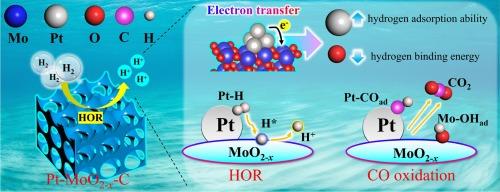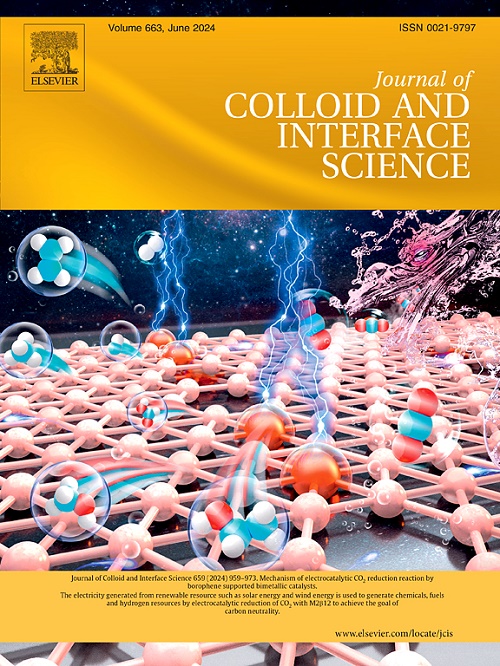Construction of directional electron transfer from Pt to MoO2-x in macroporous structure for efficient hydrogen oxidation
IF 9.4
1区 化学
Q1 CHEMISTRY, PHYSICAL
引用次数: 0
Abstract
Hydrogen oxidation reaction (HOR) as the anode reaction in proton exchange membrane fuel cell, usually suffers from the high loading of platinum (Pt) and subsequent CO poisoning especially by using industrial crude hydrogen as fuel. In this work, we propose a directional electron transfer route from Pt to MoO2-x in the macroporous structure to significantly enhance the HOR activity as well as the CO tolerance, which is constructed by interface engineering and defect strategy to anchor highly dispersed Pt nanoparticles onto the three-dimensional MoO2-x-C framework. The optimized 2Pt-MoO2-x-C with 1.02 wt% Pt demonstrates higher HOR peak current density (3.57 mA cm−2) and nearly 25 times higher mass activity than 20 wt% Pt/C. The excellent HOR performance is attributed to the synergistic effect between Pt and MoO2-x species, in which the charge transfer from Pt to MoO2-x improves H2 adsorption ability of Pt and accelerates the activation of H2 due to the reduced hydrogen binding energy of MoO2-x caused by Pt-O construction, leading to the release of H* thereby the enhancement of HOR activity. The construction of three-dimensional macroporous structure enhances the HOR dynamics by promoting the conductivity, mass transfer and the exposure of active sites. Moreover, the formed Mo-OH in Pt-MoO2-x-C can effectively react with CO species to remove the CO poisoning of Pt, endowing the excellent CO tolerance.

在大孔结构中构建从 Pt 到 MoO2-x 的定向电子转移,以实现高效氢氧化。
氢氧化反应(HOR)作为质子交换膜燃料电池中的阳极反应,通常会受到铂(Pt)负载过高以及随后一氧化碳中毒的影响,尤其是在使用工业粗氢作为燃料时。在这项工作中,我们提出了一条从铂到大孔结构中的 MoO2-x 的定向电子转移路线,通过界面工程和缺陷策略将高度分散的铂纳米粒子锚定在三维 MoO2-x-C 框架上,从而显著提高了氢氧根活性和对 CO 的耐受性。优化后的 2Pt-MoO2-x-C 与 20 wt% Pt/C 相比,铂含量为 1.02 wt%,具有更高的氢氧峰值电流密度(3.57 mA cm-2)和近 25 倍的质量活性。Pt 与 MoO2-x 之间的电荷转移提高了 Pt 对 H2 的吸附能力,同时由于 Pt-O 构建降低了 MoO2-x 的氢结合能,加速了 H2 的活化,导致 H* 的释放,从而提高了 HOR 活性。三维大孔结构的构建促进了传导、传质和活性位点的暴露,从而增强了 HOR 的活性。此外,Pt-MoO2-x-C 中形成的 Mo-OH 能有效地与 CO 物种发生反应,消除 CO 对铂的毒害,从而赋予铂优异的 CO 耐受性。
本文章由计算机程序翻译,如有差异,请以英文原文为准。
求助全文
约1分钟内获得全文
求助全文
来源期刊
CiteScore
16.10
自引率
7.10%
发文量
2568
审稿时长
2 months
期刊介绍:
The Journal of Colloid and Interface Science publishes original research findings on the fundamental principles of colloid and interface science, as well as innovative applications in various fields. The criteria for publication include impact, quality, novelty, and originality.
Emphasis:
The journal emphasizes fundamental scientific innovation within the following categories:
A.Colloidal Materials and Nanomaterials
B.Soft Colloidal and Self-Assembly Systems
C.Adsorption, Catalysis, and Electrochemistry
D.Interfacial Processes, Capillarity, and Wetting
E.Biomaterials and Nanomedicine
F.Energy Conversion and Storage, and Environmental Technologies

 求助内容:
求助内容: 应助结果提醒方式:
应助结果提醒方式:


